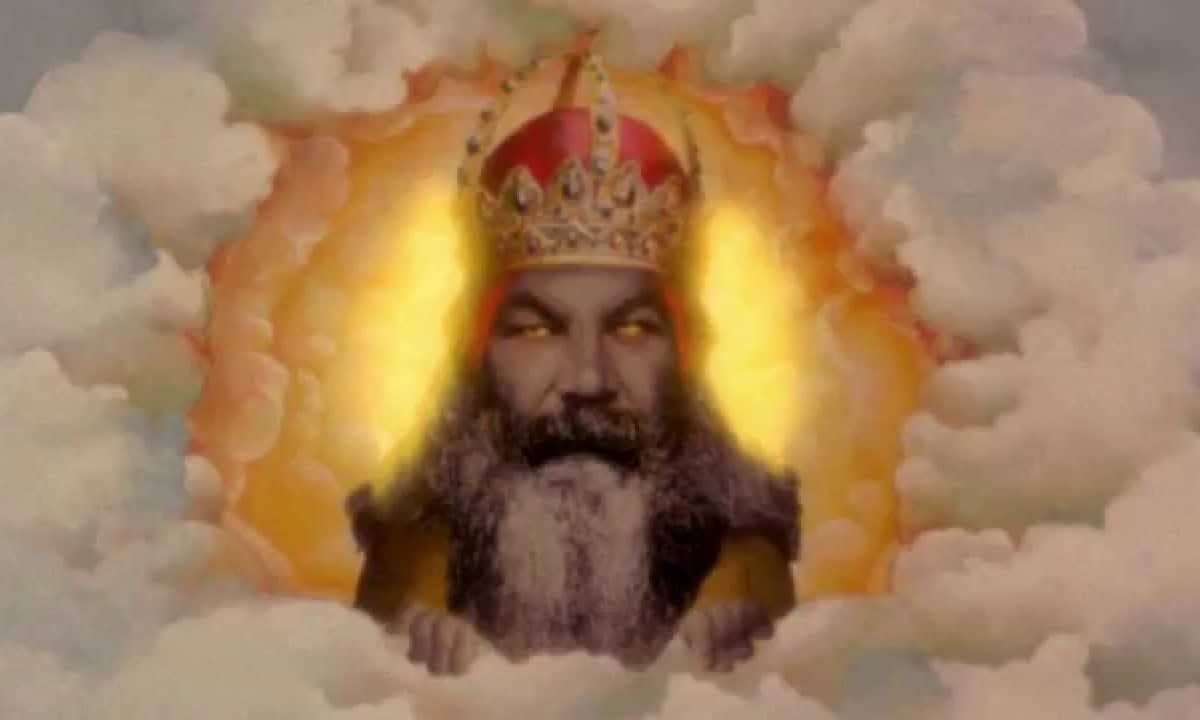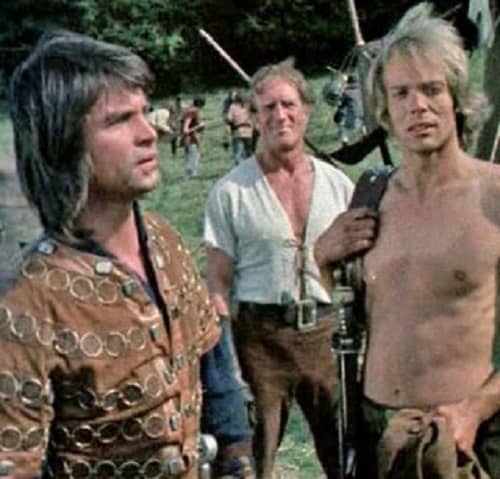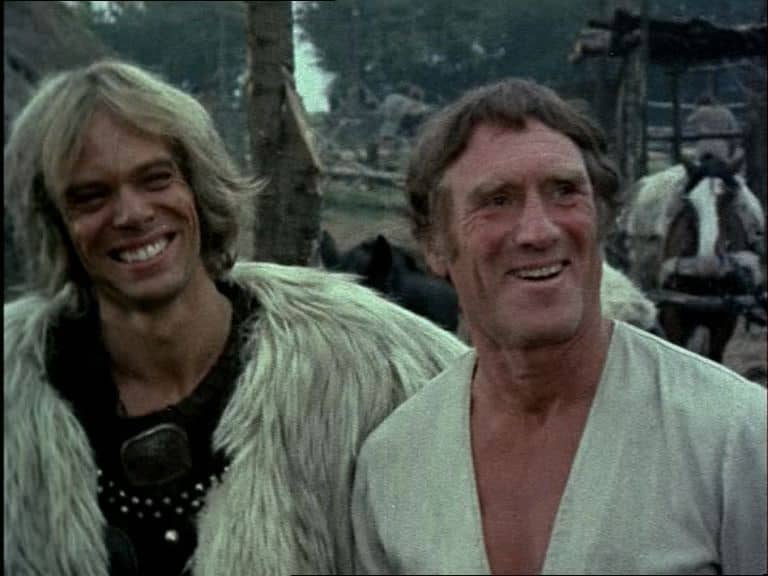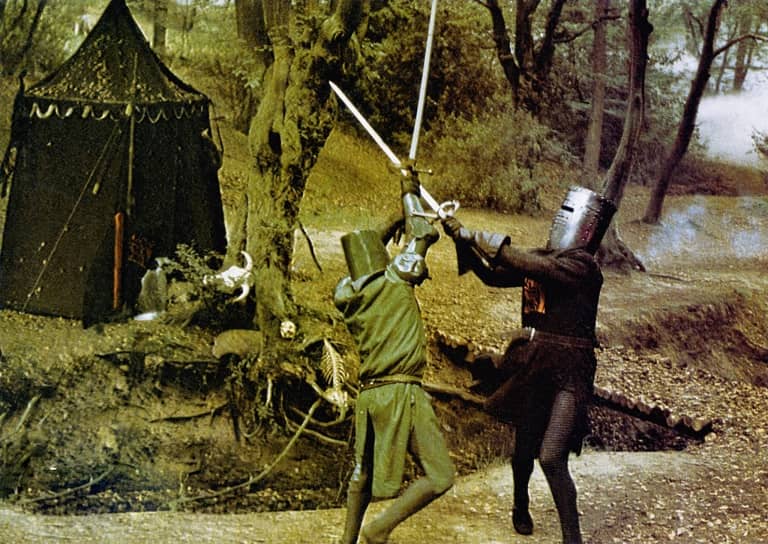Ellsworth’s Cinema of Swords: Arthur, King of the Britons
Monty Python and the Holy Grail (UK, 1975)
So, you think The Green Knight is a different cinematic take on the Arthurian legends? Well, okay, it is, but let’s go back to the early Seventies, the first time the Brits were really breaking the mold of Camelot and rolling out the Round Table.
Arthur of the Britons, Season One
Rating: ***
Origin: UK, 1972
Director: Sidney Hayers, et al.
Source: Network DVDs
Britain’s ITV network had several fine historical adventure shows early on, including The Adventures of Sir Lancelot (1956) and Sir Francis Drake (1961), but it was a long decade until their next one, Arthur of the Britons, in 1972, and in that time a lot of things changed, including tastes in historical sagas. Hollywood’s Technicolor past was out, replaced by gritty realistic history, at least as it was seen fifty years before now. This series was set during the time of the historical Arthur — if he existed — a time shortly after the Romans left British shores and the Saxons came across the narrow sea to fill the power vacuum. Here, “King” Arthur is one of many Celtic warlords resisting the Saxon advances, but the only one with the vision to see that the Celts must unite under a single leader if they are to hold the parts of Britain still under their control.
There isn’t much of the classic Arthurian tales and legends here: Arthur (Oliver Tobias) still has a foster brother named Kai (Michael Gothard), but here it’s Kai who’s adopted, the son of the Celtic warrior Llud (Jack Watson), a craggy old veteran who trained both boys in arms. The arms are those of the sixth century: axes, spears, short swords and long, with nary a jousting lance or suit of plate armor to be seen. Instead, it’s all furs, studded leather, and the occasional shirt of mail; think of it as an early take on the period depicted in Bernard Cornwell’s Last Kingdom series. But in this series, there’s no Merlin, no Lancelot, and no Guinevere, though there are a couple of quarreling cousins named Gawain and Gareth.
The twelve 25-minute episodes are discontinuous, each telling its own story, so the situation doesn’t really change as the season unfolds. The stories are quite good, most of the first season penned by veteran screenwriter Terence Feely, with a solid mix of characterization, medieval Celtic politics, and action. The combat, and there’s plenty of it, is well staged and credible, and the battle tactics the Celts use against the Saxons match what little we know of the period.
Once past the first episode, in which everyone shouts all the time, the acting is quite decent, though top-billed Tobias as Arthur is outdone by Gothard’s Kai, with his rugged charisma and crooked smile. The only person more rugged than Kai is walking oak tree Jack Watson as Llud — except for the four episodes in which force-of-nature Brian Blessed appears as the loud and robust Mark of Cornwall. The best of these is the last episode, “The Prize,” but other standout episodes include the third, “The Challenge,” and the sixth, “The Duel,” which pits Llud against Mark.
This series was rerun frequently in the UK in the Seventies, and was also shown in France, Germany, and Brazil. Several episodes were edited into a feature titled King Arthur, The Young Warlord (1975), but you may find that it’s out of print. Worth a look, though.
Arthur of the Britons, Season Two
Rating: ***
Origin: UK, 1973
Director: Sidney Hayers, et al.
Source: Network DVDs
This series picks up where season one left off, but with a couple of differences. First, several recurring characters are added to the cast, and stories and themes are carried on from one episode to the next, so watching order makes a difference.
Second, where the first season seemed almost to be more about Kai (Michael Gothard) than Arthur (Oliver Tobias), this time most of the stories center squarely on Arthur as the leader of the Celtic alliance. Of the recurring characters, two in particular stand out: Princess Rowena (Gila — that’s her whole name), the spirited daughter of Yorath, a Jute warlord, and the rousing return of King Mark of Cornwall (Brian Blessed), who steals every scene he appears in. There’s real chemistry between Arthur and Rowena, and when Mark is added into the mix as well, things get spicy.
The high quality of the writing established in the first season is retained in the second, and maybe even improved upon. The production budget is still low, but the attention to historical detail is impressive for a 25-minute afternoon adventure show, and the vigorous combat is often intense and suspenseful. 90% of the scenes are exteriors, shot in the lovely, muddy British countryside, and it does wonders for the verisimilitude.
Several episodes in particular stand out. The third regular member of the cast, craggy Jack Watson as Llud of the Silver Hand, gets an ep to himself, “Go Warily,” in which he’s dogged by a premonitory dream. The nightmare gets repeated a few too many times, but we don’t mind because the Celtic warlord Brandreth and his evil twin brother are both played with gusto by Tom Baker (Dr. Who).
Then there’s the Rowena sequence, starting, naturally enough, with “Rowena,” which introduces the feisty princess and her on-again, off-again romance with Arthur. In “Some Saxon Women,” Rowena single-handedly maneuvers Arthur into opposing the traffic of captive slaves, which is right for Arthur’s character though ahistorical as hell, as every tribe in the period engaged in the dreadful practice of slavery and would for centuries more.
Third and best of all is “The Marriage Feast,” in which King Mark persuades Rowena that he loves her, when what he really loves is the land she would bring to a marriage. Arthur tries to kibosh the wedding by tricking Mark into losing his temper, but the smug King of Cornwall just smiles at every outrage and remains “as sweet as hazelnuts,” as he puts it. It’s hilarious. Both Rowena and Mark feature in two other episodes apiece, and they’re all worth watching.
It’s also worth mentioning that the series has a catchy and fanfare-blaring title theme by Elmer Bernstein (The Magnificent Seven) that he probably knocked out in about 90 minutes, but which I guarantee you’ll be humming for a week. Duh-dun-da-DAH, dun-duh-dun-da-dah…
Monty Python and the Holy Grail
Rating: ***** (Essential)
Origin: UK, 1975
Director: Terry Gilliam and Terry Jones
Source: Netflix streaming video
There’s no point in trying to say something new about the comedy in this rightfully revered Arthurian farce, even if its gags hadn’t been quoted to death by two generations of nerds. No, we’re here to talk about Holy Grail as a historical adventure film, a company in which it is as comfortable and welcome as the rude jester in a king’s court.
The Pythons were intent on skewering tales of knights in shining armor, a goal they achieved in part because they understood those tales so well, not just from Hollywood epics, but from Arthurian literature studied at Oxford and Cambridge. They knew exactly what tropes they wanted to subvert and turned them inside out with relish and gusto.
The cliché of the knightly duel, two heavily armored warriors hammering each other with greatswords, is disposed of early in the film with the challenge of the Black Knight at the ford, where the trope is literally dismembered. So much for knightly duels. Next comes the rescue of the imprisoned maiden, in which Sir Lancelot (John Cleese) charges into a castle and indiscriminately slaughters the guests of a wedding feast. So much for the lone hero facing impossible odds. Then comes the chaste Sir Galahad (Michael Palin), tempted by seductive maidens….
The film is remarkably well paced and composed considering directors Terry Gilliam and Terry Jones hadn’t previously made anything longer than a TV comedy sketch. They clearly had a solid grasp of the classics: Scene 24, in which King Arthur (Graham Chapman) and Sir Bedevere (Jones) meet a creepy soothsayer in a haunted forest is clearly based on the similar scene in Kurosawa’s Throne of Blood, while the preparation-for-battle montage at the end, with its grim-faced veterans lining up in the mist, callused hands gripping their weapons, evokes the prelude to the Battle of Agincourt from Olivier’s Henry V. All so it can be taken down for a laugh, of course.
The medieval adventure tropes the film doesn’t upend for comic effect it instead doubles down on, also for comic effect. The common folk of the Middle Ages are depicted as wallowing in abject squalor, prey to ignorance, superstition, and fear of the word “Ni!” — except when they’re members of anarcho-syndicalist communes or connoisseurs of suburban shrubbery, the Humor of Incongruity being a Python specialty.
This movie is nearly a half-century old, so one supposes it’s remotely possible that you haven’t seen it. If so, it’s a (doubtless inadvertent) lapse that should be corrected immediately. Get thee to thy streaming service, varlet.
Where can I watch these movies? I’m glad you asked! Many movies and TV shows are available on disk in DVD or Blu-ray formats, but nowadays we live in a new world of streaming services, more every month it seems. However, it can be hard to find what content will stream in your location, since the market is evolving and global services are a patchwork quilt of rights and availability. I recommend JustWatch.com, a search engine that scans streaming services to find the title of your choice. Give it a try. And if you have a better alternative, let us know.
Previous installments in the Cinema of Swords include:
Flynn’s Last Flourishes
Mighty Colossi And Hydrae
Rejecting Bushido (Part One)
Pirates — Italian Style
The Year of Camelot and Scarecrows
Rejecting Bushido (Part Two)
The Fall of the Hollywood Epic
Cheh’s On Second
En Garde, Old Boy
More Hammer Historicals
Zatoichi’s Finest
A Little History
Lone Wolf and Cub, Part I
Premium Peplum
The Book Was Better
Shogunate’s End
Peak Musketeers
Lone Wolf and Cub, Part 2
LAWRENCE ELLSWORTH is deep in his current mega-project, editing and translating new, contemporary English editions of all the works in Alexandre Dumas’s Musketeers Cycle, with the fifth volume, Between Two Kings, coming in July from Pegasus Books in the US and UK. His website is Swashbucklingadventure.net.
Ellsworth’s secret identity is game designer LAWRENCE SCHICK, who’s been designing role-playing games since the 1970s. He now lives in Dublin, Ireland, where he’s writing Dungeons & Dragons scenarios for Larian Studios’ Baldur’s Gate 3.




I have seen several Arthurian scholars argue, quite (semi-)seriously, that the John Cleese version of Lancelot, with his disastrous “rescue” of a (non-)damsel in distress, is the most accurate depiction of the literary Lancelot yet seen on screen.
Re ‘Arthur of the Britons’. I actually have the boxset. I watched it as a kid and was fascinated to see how it stood up. Pretty well, especially in terms of script! I guess the old Star Trek would be the most obvious example of a series that revolved around three male characters. The dynamic works very well here, and I think each of the three bring just what is needed to each story. Plus it looks great, although one thing did strike me – it’s also a feature of ‘The New Avengers’ – this being the relative sparsity of extras (maybe the unions had more clout back then and extras were just paid more?). It’s rarely a problem apart from one battle that makes your average soccer pitch look crowded by comparison.
Plummy English accent notwithstanding, Tobias is actually Swiss – his full name is Oliver Tobias Freitag (I think).
Another Ellsworth’s Cinema of Swords? Blessed Again!
I can’t add anything regarding the Python film but thanks much for reviewing Arthur of the Britons, another gem I’ve never even heard of. I’m starting to think that anything is better with some Blessed in it and what I’ve seen on YouTube bears me out.
You’re right about that theme song, although it is no Flashing Blade, thank goodness. I was whistling that one in the pissoir for a month.
Thanks for the post!
‘Arthur of the Britons’ was an expensive enough production for its time and for what it was – Elmer Bernstein actually composed the theme for it, which must have cost a few bob.
ARTHUR OF THE BRITONS sounds very interesting. Most filmed Arthurian stories show little interest in the historical period Arthur supposedly lived in.
“There isn’t much of the classic Arthurian tales and legends here: Arthur…still has a foster brother named Kai…”
This kinda sums up much of the last 1000 years of Arthurian legends. No matter what changes from version to version, from the 12th century to the present day, Kai (or Kay, or Che or whatever) is almost always there, often as Arthur’s rude, self-important seneschal (or some other prominent court figure, such as a gatekeeper).
I think his peculiar consistency amid the changing stories comes from having a simple one-syllable name often attached to a strong personality trait. Particularly if you’re passing a story down orally, it’s hard to forget or misremember the guy with the ridiculously simple name whose pastime is making fun of his colleagues (you didn’t think Monty Python invented the idea of rude knights, did you??).